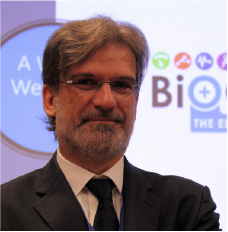
D. Demarchi POLITO

mar 31
The importance of technology is increasing in guaranteeing a sustainable agriculture and to ensure high quality in the final product for the consumers. During the Digital Food Conference “IOT for precision Acgriculture” we will explore application and technological scenarios based on intelligent electronic systems for: crop monitoring, information communication and decision support.
We will as well expose the state of the art of multi-sensing solutions and communication systems useful in agriculture, together with the future scenarios of the application of digital technologies to precision agriculture.
We are pleased to talk about "Smart systems for innovation in agriculture" with:


Danilo Demarchi:
If I understand correctly the answer is: to my knowledge no, not yet. We are still, as I said, in a stage of research that is beginning to be applied, because there are already some industrial applications, of industrial sensors. But I haven’t seen punctuality yet.
Because the issue touched on by the question is certainly very important, that is: we are talking about crops, generic cultivars, but rightly then the cultivar, maybe not specifically, but there are different types, even quite different from each other.
From the point of view of who makes the sensor, generates the data, probably, here, in my case it is not so different. Certainly the dimensions change. It is one thing to work with rice and one thing to work with an apple tree.
So obviously, from the point of view, let’s say, precisely of the geometries, of the materials and of what are the dimensions of the things that we can implement, they certainly change. But I have not yet seen such timely solutions.
We are still solving problems first, in the sense, certainly artificial intelligence is very useful to put all things together, but it is also important to generate as little as possible, that is, we need to find the right balance. From the point of view of the sensors, to reduce them, this is why the studies are also linked to the fact of saying that in the end with that sensor I cover two. Here then I can reduce. So going to reduce and then instead here yes that in my opinion at a higher level and then I can customize, I can take the data because in my opinion the same data, applied (since it has been mentioned) to rice rather than to the apple tree, can also have different meanings from the point of view of reactions.
Luca Bolognini:
In terms of principle we do not see great difficulties, in the sense that it was previously mentioned by the Professor as there is a possibility of working on device, that is, the plant on edge, the field, and a cloud. So it’s just a problem to find the algorithm with the right data and reaction times, but I believe that there can be an absolutely (at least in terms of principle) very clear and evident parallel with what we already do in industrial practice, so don’t there is absolutely a prejudice in scaling intelligence on different dimensional levels, therefore from the proximity of the plant to the field and the cloud. It is only a problem I would say to try it, but, also taking up part of the previous question, it is very true that there are no off-the-shelf solutions ready for the specific cultivar, but the method gives us comfort because it is absolutely universal.
So in this we have a robustness in the approach that which leads us to conclusions I still believe ad hoc and personalized but potentially extreme and of extreme thickness and robustness.
Danilo Demarchi:
Fundamental question especially for the Italian economy, where we know that we have more, many smaller producers, right? And it is precisely in the direction of low cost. That is: I see the possibility of generating extremely low cost solutions that can interact with each other with communication channels even at low cost. LoRa today has free access, or at very low costs, also because then the data exchanged are not very many. The difficulty is having enough energy to shoot it out, to put it very directly, but everything else is quite under control, so certainly today these solutions do not yet exist, but we are working on it and many companies are working on it, even now. just to generate (the solution I have in mind) are very small devices with on board that minimum of electronics necessary to interface with a sensor.
For example the solar cell.
We are working with ST on a project (I can tell you about it because we have already made a first publication) in which the cell not only generates my energy, but since it is linked to the lighting it also tells me the brightness of the environment.
So the work to do is to intelligently use the technologies we have available to take the data from the sensor, process it and, in a very small space, with a non-consumption of power. Because of course there is power consumption, but there is no battery, therefore self powered, and at that point I transmit and these devices can come to cost very little precisely because (and here I close) if you think about it the power of microelectronics from a commercial economic point of view it was scaling, that is, producing millions of chips reduces me
If you imagine, pay a few euros for devices that have millions of transistors inside. There is just a gap between what it does versus how much I pay it.
And in agriculture the scaling is there. As I said, I am not going to put the sensor for each plant, however I do not put two for each for each cultivable area.
So this is why there is interest on the part of electronics manufacturers in the topic because it can be, in my opinion, a really new scenario, a new economic scenario that allows electronics (and therefore I see it as electronic) to open up. a market similar to what there has been in mobile phones, ie from an economic and scaling point of view we can reach even higher numbers. So here’s why, but you have to have a little patience, we’re not there yet.
Luca Bolognini:
It really depends on the application. It is one of. It is certainly one of the. In more complex cases we even go to an ensemble of algorithms that generates an estimate of which we then go to make a sort of envelope, pass me the term.
So it depends a lot on the type of application, but it is certainly one of those, for example, for explanatory models so that they want to find a cause and effect connection of a complex system, it is certainly one of those applicable, absolutely.
Danilo Demarchi:
Yes, this is another extremely interesting application, that is, there are already investments precisely because, as Engineer Bolognini said before, the application he showed us, if they want it is even easier to go to work.
Okay, you worked in clean rooms, let’s say, we’re halfway there. But go to work in the environment.
In the city, going to work in more controlled environments, things get easier. So whether it is vertical or horizontal, from the point of view of technology it does not change and another aspect that comes out of this question is aquaponics.
Cultivation through water which is another factor, another channel, let’s say, of an extremely interesting solution and we for example have a regional project with a company in which we are developing the technologies to do, to generate industrial solutions using aquaponics that must absolutely be kept in mind.
What the agronomist experts told me is that in Italy perhaps at the moment this is not the solution.
For example, working with Israel, you can imagine, however, that they are very interested. In fact, we even did things with them.
But, let’s say, if we want to move certain things later in the urban environment, it will certainly also become interesting in my opinion at an Italian level. We say Southern Europe, because Southern Europe does not yet have this need. Northern Europe, on the other hand, has it and in fact in Northern Europe they are working more on these things than we are.
Digital Food Ecosystem is a partnership led by aizoOn in collaboration with technology partner companies, universities and research centers offering solutions in the Agrifood sector that meet challenges and specific needs of companies in three different areas:
DFE’s ability to propose arises from the experience and results obtained in the Food Digital Monitoring (FDM) research program.
DFE is an ecosystem that provides the agrifood chain with a specific and distinctive capacity for digital innovation, complete in terms of approach, methods, tools and technologies.